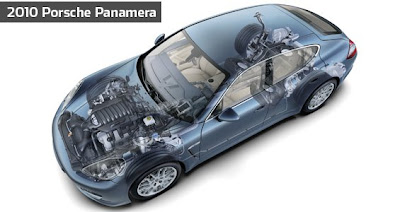"Is it understeering much?" I howled out to the driver of the $133,550 500-hp Porsche Panamera Turbo, as I braced for a ninety-degree left that was approaching with comical speed. "Oh, naaaa. It just goes where you point it" responded the Zen-calm Porsche test driver. Nuts. Our technical introduction to Porsche's new four-door hatchback sedan at the autoamaker's Weissach think tank had concluded with an unexpected series of flying laps around Porsche's kart-tight test course -- but with we journalists as passengers only. No driving, and hence no driving impressions. Porsche has planned that for later. And now my clumsy attempt to dupe the driver into just giving me a hint of what he was feeling had been greeted with a diplomatic, but uninformative, answer.Or was it? Actually, the car did seem to be going exactly where it was aimed. And moreover, while producing utterly improbable, face-twisting lateral g loads for a car that weighs 4344 pound and stretches 195.7 inches. This is a big, big car, and it's snaking around the track's narrow ribbon of asphalt fast enough to give Captain Bligh motion-sickness. Maybe a trio of g-hardened test pilots could stand this for awhile, but otherwise it's essentially a car that's faster than mortal passengers can endure.
The Panamera's weight (4101 lb for the 400-horsepower all-wheel-drive non-turbo Panamera 4S, and 3903 lb for the rear-drive S) is deceptive. Porsche has been fanatical in trimming unnecessary pounds and has extensively employed lightweight materials up front to offset the engine's mass. Much of the car's nose structure is composed of aluminum (including the hood, front fenders, doors, rear hatch, and an almost Brancusi-like cast engine cradle), with even magnesium making an unusual appearance near the nose. Moreover, there are occasionally even bits of nothing -- for instance, the engine bay's normally closed sides have large cutouts as if something's missing. Porsche realized that the front wheel's plastic wheel housings were sufficient. Why waste material?
All this weight reduction hasn't rendered the Panamera a rackety drum inside. In fact, it's remarkably quiet as the driver flat-foots the direct-injection 4.8L twin-turbo V-8 and it begins that throaty bellow that's so characteristically Porsche (credit a body shape that's been carefully crafted from the get-go for low-hiss acoustics). Oddly, you don't hear much whistle from the turbos; that's been deemed more appropriate for the sports cars and largely muted from the Panamera's sonic vocabulary.






No comments:
Post a Comment